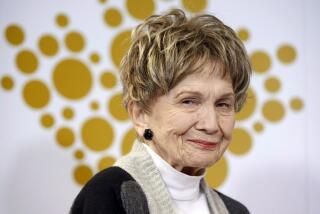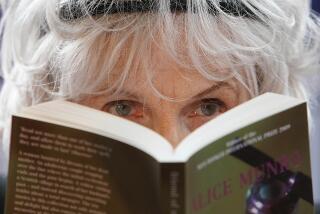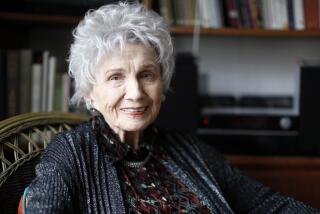‘Too Much Happiness’ by Alice Munro
Too Much Happiness
Stories
Alice Munro
Alfred A. Knopf: 320 pp., $25.95
“No way this could be seen as probable or possible, unless you think of a blow between the eyes, a sudden calamity,” muses the narrator of “Fiction,” one of the 10 masterly stories that make up Alice Munro’s latest collection, “Too Much Happiness.” “The stroke of fate that leaves a man a cripple, the wicked joke that turns clear eyes into blind stones.” It sounds as if she were talking about violence. In fact, she is talking about someone falling in love. But love also can be a type of calamity, and shares with violence a deep unpredictability, a disturbing power to alter radically the course of one’s life.
The power of random events lies at the heart of “Too Much Happiness.” Nearly every story here hinges on some calamity, some unanticipated and mostly arbitrary event. Such things appear, before they happen, neither probable nor possible, though afterward they may well come to seem inevitable. These are calamities of love, or more frequently of violence: violence inflicted by accident and illness, or violence inflicted by other people, usually men. “Men. What they do. It’s so sick and stupid. You can’t believe it,” one character reflects. “That’s why it’s true.”
Indeed, I cannot recall a collection of stories, by Munro or any other writer, that features so many examples of lunacy, of irrationality, by men and women alike. There are the extreme cases, including Lloyd, the delusional abusive husband of the opening story, “Dimensions,” and the apparently sociopathic antagonist of the chilling “Free Radicals.” There are the oddballs and eccentrics, such as Kent, the deeply disturbed prodigal son of “Deep-Holes,” and Mr. Purvis, the bizarre and creepy exploiter of young women in “Wenlock Edge.” There are the unintelligent, such as Edie (“Fiction”), whose mind “plods inexorably from one cliché or foolishness to the next and proclaims every step of the journey to be the law of the land,” and Verna, in “Child’s Play,” whose status as mentally challenged is feared and resented by the story’s narrator, Charlene. And there is something far more disturbing too: apparently “normal” people who discover unsuspected capacities for abnormal and even, at times, radically malignant behavior.
The unintelligibility of such characters, and of the world itself, is not only a challenge to the people confronted with it; it is also a challenge to the author, a kind of rebuke to the fundamental goal of writing fiction, which is by its nature an attempt to make sense of the world. (“You wouldn’t understand that,” Kent tells his mother in “Deep-Holes.” “I’m not in your world, you’re not in mine.”) The impenetrable walls that shield the minds of these people must present a sickeningly tempting challenge. But how much, really, can a writer -- a writer of short stories, for goodness’ sake -- expect to accomplish in the face of such daunting opacity?
Munro is aware of these issues, and is willing to have a certain degree of fun with them. “Fiction” features a protagonist who discovers, unexpectedly, that she has become a character in a book written by a person she barely remembers. Upon opening the book, she finds herself thinking:
“ ‘How Are We to Live’ is the book’s title. A collection of short stories, not a novel. This in itself is a disappointment. It seems to diminish the book’s authority, making the author seem like somebody who is just hanging on to the gates of Literature, rather than safely settled inside.”
No reader will miss the sly, knowing wink in this passage. But most interesting is the way the author of “How Are We to Live” remains distant and inscrutable, even after the protagonist conceives a desire to reconnect with her. Just what is the relation, “Fiction” asks, between reader and story, and between reader and author, and how much of either relationship is itself fictional?
Our greatest work of fiction, “Too Much Happiness” seems to suggest, is the construction of a shared social life to serve as a comforting bulwark against the dangerous contingency of the world. So much short fiction shies away from this complexity, presenting a pared-down vision of reality, stripped to what the author sees as life’s essential principles. Munro’s stories, by contrast, remind us that the non-essential things -- the things that didn’t have to happen, that could have been avoided if people were a bit more rational, or a bit more careful, or if the world just made a bit more sense -- so often determine the shape of a life. In doing so, they remind us that comfort and security are by their very nature essentially fragile and ephemeral, if not largely illusory.
“I was writing a good essay,” reflects the naïve student who narrates “Wenlock Edge.” “I would probably get an A. I would go on writing essays and getting A’s because that was what I could do. The people who awarded scholarships, who built universities and libraries, would continue to dribble out money so that I could do it.” Then she concludes: “But that was not what mattered. That was not going to keep you from damage.”
And she is right. Writing good essays is not going to keep you from damage. Nor is writing good stories, no matter how safely settled one may be inside the gates of literature -- or, for that matter, inside any other fantasy. Faced with such a world one might well wonder: How are we to live? That is the question Munro has asked throughout her career, and continues to address in this remarkable new book.
Jollimore is the author of “Tom Thomson in Purgatory,” which won the 2006 National Book Critics Circle Award in poetry.
More to Read
The biggest entertainment stories
Get our big stories about Hollywood, film, television, music, arts, culture and more right in your inbox as soon as they publish.
You may occasionally receive promotional content from the Los Angeles Times.










